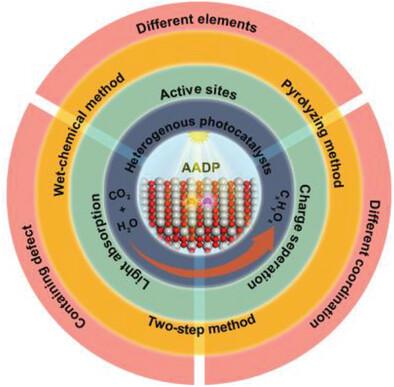当前位置:
X-MOL 学术
›
Adv. Mater.
›
论文详情
Our official English website, www.x-mol.net, welcomes your feedback! (Note: you will need to create a separate account there.)
Asymmetric Atomic Dual‐Sites for Photocatalytic CO2 Reduction
Advanced Materials ( IF 27.4 ) Pub Date : 2024-07-23 , DOI: 10.1002/adma.202403153 Guangri Jia 1 , Yingchuan Zhang 1 , Jimmy C. Yu 2 , Zhengxiao Guo 1
Advanced Materials ( IF 27.4 ) Pub Date : 2024-07-23 , DOI: 10.1002/adma.202403153 Guangri Jia 1 , Yingchuan Zhang 1 , Jimmy C. Yu 2 , Zhengxiao Guo 1
Affiliation

|
Atomically dispersed active sites in a photocatalyst offer unique advantages such as locally tuned electronic structures, quantum size effects, and maximum utilization of atomic species. Among these, asymmetric atomic dual‐sites are of particular interest because their asymmetric charge distribution generates a local built‐in electric potential to enhance charge separation and transfer. Moreover, the dual sites provide flexibility for tuning complex multielectron and multireaction pathways, such as CO2 reduction reactions. The coordination of dual sites opens new possibilities for engineering the structure–activity–selectivity relationship. This comprehensive overview discusses efficient and sustainable photocatalysis processes in photocatalytic CO2 reduction, focusing on strategic active‐site design and future challenges. It serves as a timely reference for the design and development of photocatalytic conversion processes, specifically exploring the utilization of asymmetric atomic dual‐sites for complex photocatalytic conversion pathways, here exemplified by the conversion of CO2 into valuable chemicals.
中文翻译:

用于光催化二氧化碳还原的不对称原子双位点
光催化剂中原子分散的活性位点具有独特的优势,例如局部调谐电子结构、量子尺寸效应和原子物种的最大利用。其中,不对称原子双位点特别令人感兴趣,因为它们的不对称电荷分布会产生局部内置电势,以增强电荷分离和转移。此外,双位点为调节复杂的多电子和多反应途径(例如二氧化碳还原反应)提供了灵活性。双位点的协调为设计结构-活性-选择性关系开辟了新的可能性。本综合概述讨论了光催化二氧化碳减排中高效且可持续的光催化过程,重点关注战略活性位点设计和未来挑战。它为光催化转化过程的设计和开发提供了及时的参考,特别是探索利用不对称原子双位点进行复杂的光催化转化途径,这里以将二氧化碳转化为有价值的化学品为例。
更新日期:2024-07-23
中文翻译:

用于光催化二氧化碳还原的不对称原子双位点
光催化剂中原子分散的活性位点具有独特的优势,例如局部调谐电子结构、量子尺寸效应和原子物种的最大利用。其中,不对称原子双位点特别令人感兴趣,因为它们的不对称电荷分布会产生局部内置电势,以增强电荷分离和转移。此外,双位点为调节复杂的多电子和多反应途径(例如二氧化碳还原反应)提供了灵活性。双位点的协调为设计结构-活性-选择性关系开辟了新的可能性。本综合概述讨论了光催化二氧化碳减排中高效且可持续的光催化过程,重点关注战略活性位点设计和未来挑战。它为光催化转化过程的设计和开发提供了及时的参考,特别是探索利用不对称原子双位点进行复杂的光催化转化途径,这里以将二氧化碳转化为有价值的化学品为例。












































 京公网安备 11010802027423号
京公网安备 11010802027423号